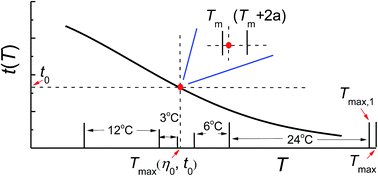Understanding the temperature–resistance performance of a borate cross-linked hydroxypropyl guar gum fracturing fluid based on a facile evaluation method†
Abstract
The evaluation of the temperature–resistance performance of fracturing fluid is essential for choosing suitable fracturing fluids during fracturing treatment. In this work, related parameters for characterizing the temperature–resistance performance of fracturing fluids have been analysed systematically. The maximum temperature, Tmax(η0, t0), which satisfies both the minimum viscosity requirement (η ≥ η0) of fracturing fluid and the time requirement of fracturing treatment (t ≥ t0), was used to characterize the temperature–resistance performance of fracturing fluids. A facile procedure for evaluating Tmax(η0, t0) has been proposed based on a step-by-step numerical-search method. The search for Tmax(η0, t0) starts from the upper limit temperature Tmax, which is the maximum temperature where the apparent viscosity meets the minimum viscosity requirement, i.e., η ≥ η0. Using a borate cross-linked hydroxypropyl guar gum fracturing fluid as an example, the effects of pH, and the concentrations of thickening agent (hydroxypropyl guar, HPG) and crosslinking agent (Na2B4O7) on the crosslink and temperature–resistance properties are also investigated. It has been found that the crosslinking time tc decreases with the increase of HPG concentration or Na2B4O7 concentration. However, tc was found to increase when pH increases. The variation tendencies of Tmax(η0, t0) are different from that of Tmax, viz., Tmax(η0, t0) gradually increases with Na2B4O7 concentration, whereas Tmax increases significantly at low Na2B4O7 concentration and remains almost unchanged at high Na2B4O7 concentration. The possible mechanisms are proposed for interpreting the above phenomena according to related crosslinking-reaction kinetics and thermodynamics. Our work demonstrates a facile method for evaluating the temperature–resistance performance of the fracturing fluid and provides useful insights into the understanding of the temperature tolerance performance of the borate cross-linked hydroxypropyl guar gum fracturing fluid.



 Please wait while we load your content...
Please wait while we load your content...